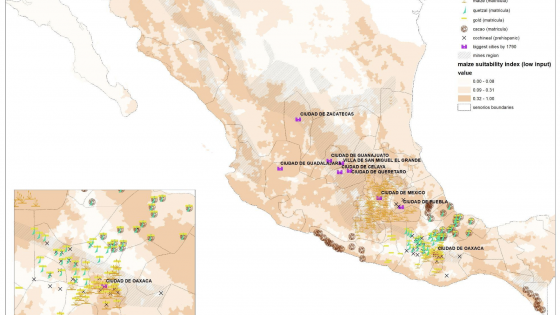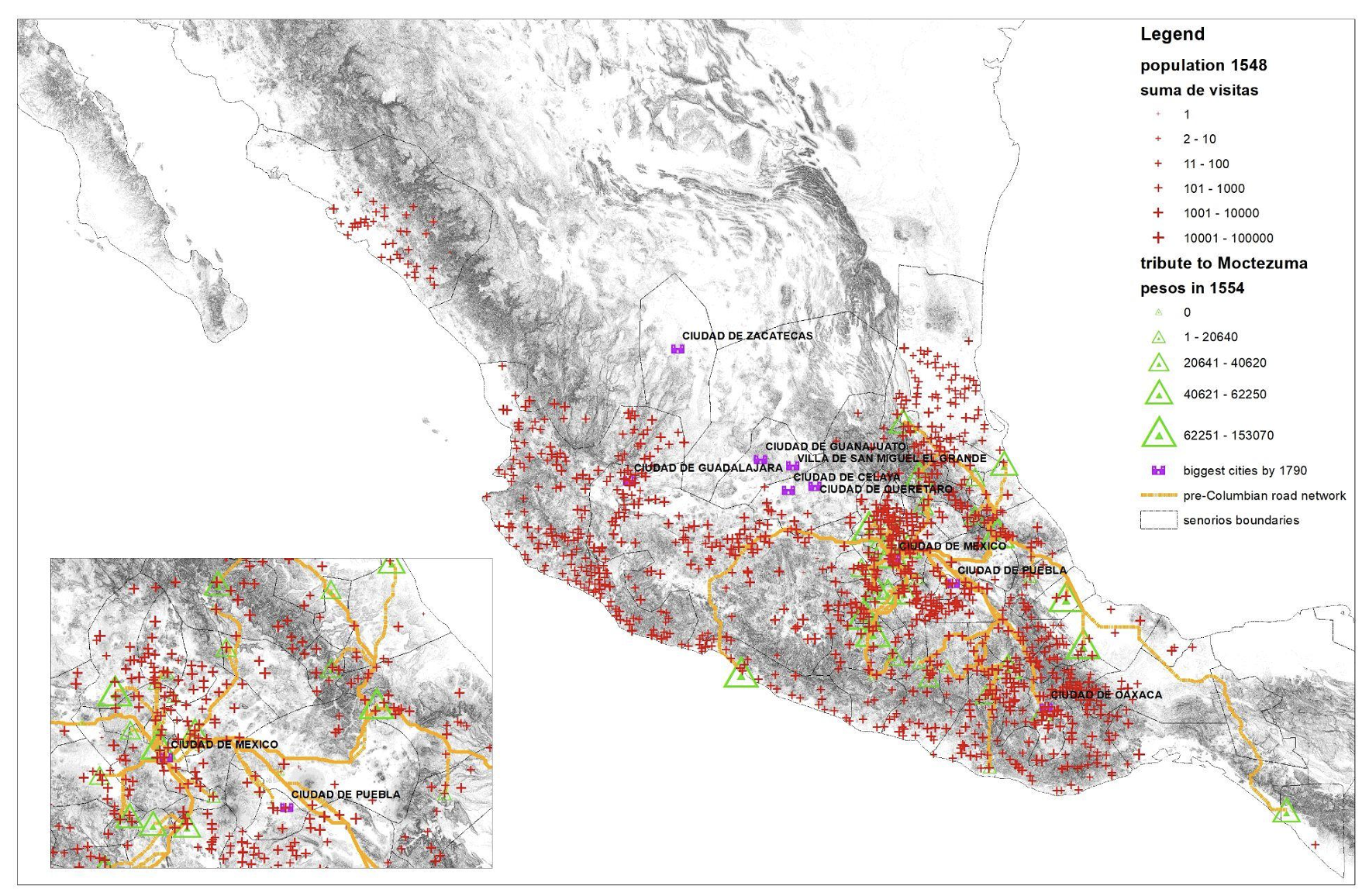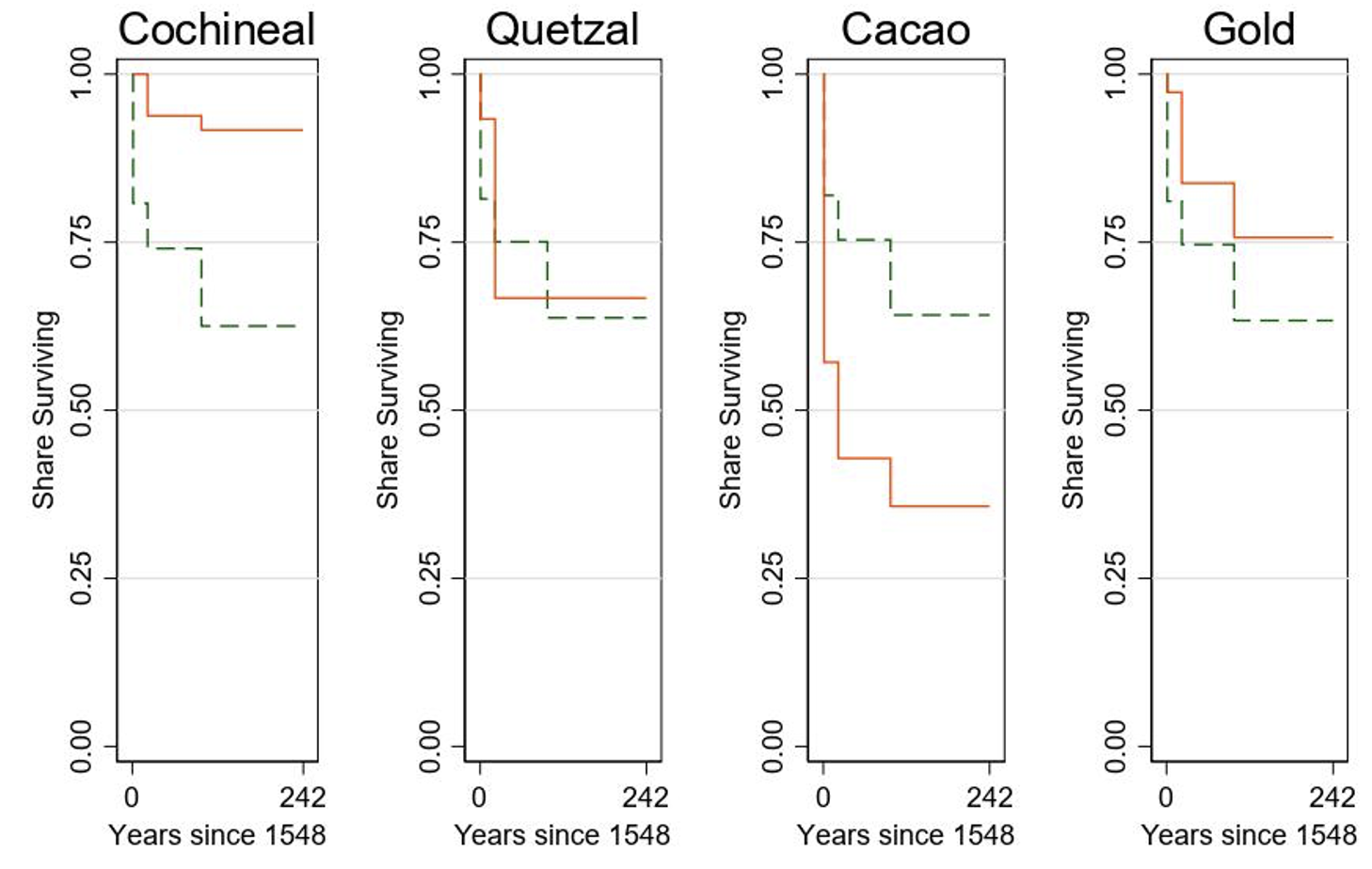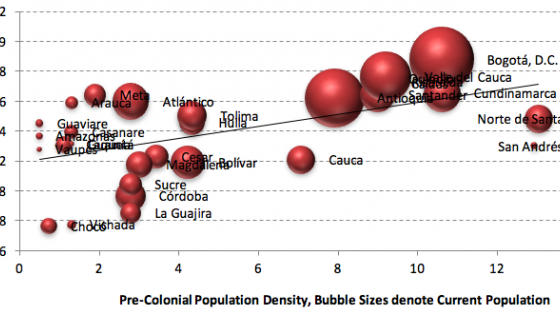Both war and pandemic have disrupted today’s global trade networks, imposing a disproportionate burden on specific countries and different ethnic groups with them. Such differential effects of a global pandemic resonate with one of the most traumatic moments in human history, the Conquest of Mexico. In its aftermath, faced by the ‘germs and steel’ of the conquistadores (Diamond 1997), millions of indigenous people died. But as we show, the disaster was far from indiscriminate. Who survived and why?
Using a rich set of primary sources, including Aztec tribute rolls and early 16th century censuses, we reconstruct the fate of 1,093 indigenous settlements (altepetl) that existed in the historic core of Mexico. Figure 1 shows striking patterns both of whole communities annihilated by the end of the colonial period, but also of indigenous resilience. Unlike in Western Europe, where the opening of trade to the New World brought rising populations to port towns (Acemoglu et al. 2005), their coastal counterparts in Mexico were decimated. In the central highlands, in contrast, the fate of settlements was more mixed. Overall, the average indigenous settlement population fell from 2,377 in 1548 to 128 by 1646. By 1790, 36% had disappeared entirely; yet 13% ended the colonial era larger than they began. What accounts for these patterns?
Figure 1 Population change in the historic core of Mexico, 1548-1790
Source: Diaz-Cayeros et al. (2022), based upon the Suma de Visitas, and the Tanck de Estrada 2005
Two theories currently prevail for the population collapse. The ‘virgin soil’ hypothesis (Crosby 2003) blames novel pathogens that reached pandemic proportions among the previously unexposed indigenous population. In contrast, the ‘black legend’, following contemporary observer Fra Bartolome de las Casas, blames the ruthless exploitation of the native population by European settlers.
Combining economic theory, modern epidemiological models and novel disaggregated data allows us to shed new light on these questions. We draw upon a simple theoretical framework (outlined in Jha 2018) that considers the conditions that support peaceful coexistence equilibria among different ethnic groups living in the same location.
When considering how trade between nations can support peace, comparative advantages are often assumed (Polachek and Sieglie 2007) and the presence of alternative trading partners can be crucial (Martin et al. 2008). When individuals live in the same place, and thus share many endowments, however, sustaining inter-group trade can be even more fragile: opportunities often emerge to violently seize or, over long time periods, replicate one another’s production processes. This fragility of the gains from trade is accentuated when one group is militarily vulnerable, such as is often the case for minority ethnic groups. Under what conditions then can market exchange support peaceful coexistence and prosperity for vulnerable groups over time?
Jha (2018) distinguishes between vulnerable indigenous groups, for whom leaving a particular location is relatively costly, and vulnerable outsider groups, such as middleman minorities, who are more mobile. He considers a setting where, every period, individuals can choose to leave, to produce a good, and to target another with violence to seize their profits. The paper shows that, in this environment, a set of conditions become necessary for supporting equilibria with ethnically mixed populations and no violence over long horizons. The first is that members of different groups are able to maintain economic activities that complement, rather than compete with, one another. Further, the source of complementarity for vulnerable group members has to be very costly to expropriate and replicate. This is often the case for middlemen minorities, such as Muslims in medieval Indian Ocean ports, whose complementarity stems from access to external trading networks. Trading networks are intangible, thus impossible to expropriate, and when large-scale such as due to the Hajj, become difficult to replicate.
But beyond this, over long time horizons, vulnerable group members need to be able to credibly threaten to withhold their complementary production in order to deter expropriative violence. Jha (2018) describes how, when their outside options are good, such as occurs with falls in barriers to immigration elsewhere, vulnerable outsiders that enjoyed robust complementarities, such as trading minorities in Indian Ocean ports, Europe and elsewhere, have been able to deter acquisitive dictators and others by threatening to leave and deny future trade. However, when the costs of leaving where high, these communities were more likely to see waves of pogroms instead (Jha 2013, 2018).
Conquest-era Mexico exemplifies an even tougher environment for sustaining peace and prosperity for the vulnerable. Indigenous communities, whose knowledge, endowments, and networks also are concentrated locally, often find it even more costly to leave a specific location, not less. With nowhere to go, even if indigenous groups produce a valuable good, they are at risk of being expropriated and coerced into its production through the threat of violence. To be able to withhold production and deter violence, therefore, their effort needs to be difficult to monitor and therefore coerce (Diaz-Cayeros and Jha 2017, Jha 2018). In our new paper (Diaz-Cayeros et al. 2022), we confirm that the extent to which this was true played crucial roles in shaping the resilience of indigenous peoples in the Americas after the Conquest.
Our findings suggest that rather than facing indiscriminate death from disease and coercive violence, indigenous communities were highly resilient when they could produce goods that embedded indigenous knowhow and skill that were hard to transplant elsewhere and also prized on international markets. A key example was cochineal, an indigenously domesticated insect that was also the best-known source of red dye until the development of synthetics in the 1880s (Baskes 2000, Diaz-Cayeros and Jha 2017). Highly fragile, cochineal production required strong incentives, specific micro-climates, and special techniques to keep the insects alive. Difficult to monitor and to transplant, it would remain an indigenous activity despite becoming the most valuable processed good exported from New Spain (Baskes 2000, Diaz-Cayeros and Jha 2017). We contrast cochineal-producing settlements to those producing other internationally valued goods. Cacao, the drink of Aztec nobles, was also native to Mexico but easily planted and replicated elsewhere. Gold and silver production could be monitored and coerced. Similarly, we track the fate of settlements that produced artisanal goods, such as quetzal feathers, highly valued by the Aztec court, but dismissed by the conquering Spanish.
Figure 2 Pre-Conquest settlements producing cochineal, cacao, gold, maize and other commodities
Source: Diaz-Cayeros et al. (2022), based upon the Codex Mendoza and other Conquest-era sources.
To reconstruct Conquest-era Mexico, we exploit two unique historic documents. The Codex Mendoza, said to have been given by the last Aztec Emperor, Moctezuma, to Cortes himself at the time of the Conquest, details the tribute that different settlements owed to Tenochtitlan. We use this not only to determine which pre-Conquest settlements produced cochineal and other commodities (Figure 2), but also to develop a prediction of pre-Columbian market access and road networks. The Suma de Visitas (1548) enumerated the households in different parts of newly- conquered Mexico, based upon the ‘visits’ of clerical officials (Figure 3).
Figure 3 Reconstruction of Mexican population and market access, 1548
Source: Diaz-Cayeros et al. (2022).
We use subsequent censuses and population counts throughout the colonial period to assess settlement survival. Figure 4 summarises these findings. The graph presents Kaplan-Meier survival functions, comparing the share of settlements surviving over the colonial period that specialised in different products in the pre-Columbian period. Note that even in this raw comparison, cochineal-producing settlements are much more likely to survive throughout the colonial period.
Figure 4 Kaplan-Meier plots of the proportion of the survival of indigenous settlements producing different commodities relative to others, 1548-1790
The differences prove to be robust to tighter statistical comparisons. Compared to other settlements with similar initial populations, climatic conditions, and exogenous disease propensities, we find that indigenous settlements that produced cochineal at the time of the Conquest were at five times lower risk of disappearing each year during the colonial period, were 13 percentage points more likely to continue to exist in 1790, and enjoyed populations 1.7 times larger at the end of the colonial period. These patterns are robust to comparing Altepeme with similar imperial conquest histories and pre-Columbian market access, comparing within the same province or lordship, or accounting for spatial auto-correlation using a spectral GMM regression. The findings are not driven by the choice Spanish colonists made to locate and settle in particular places. These differences are also robust to controlling for the propensity for the pandemic diseases predicted by modern epidemiological models of the climatic envelopes for typhus, plague, dengue, and different candidates for the more mysterious cocoliztli.
In contrast, settlements producing cacao (transplantable elsewhere) and gold (whose labour could be coerced) before the Conquest, while both surviving twice as long as otherwise similar settlements in the records, show no population advantages by the end of the colonial period. Producers of quetzal feathers for the Aztec court, once a prized commodity, saw the greatest declines: quetzal-producing settlements were five to six times less likely to survive the colonial era, and their average population was 86% smaller by 1790. Thus, vulnerable communities’ ability to adjust to the threat of violence and disease depended critically on whether their skills and endowments at the moment of the Conquest positioned them to benefit from autonomy rather than subjugation.
The Mexican coastal regions, once flourishing areas of indigenous settlement, are an important example. Potentially with much to gain from the new intercontinental trades, indigenous settlements on the coasts lacked robust inter-ethnic complementarities. Instead, these settlements were well-suited for (replicable) cacao production, and susceptible to typhus. Many communities would be wiped out entirely, in part by disease and in part from the rampages of the Conquistador Nuño de Guzman, who sought to coerce and enslave them. Elsewhere, where cochineal was cultivated, encomenderos realised the benefits of giving the indigenous autonomy, instead of forcing their labour. Such autonomy appears to have allowed the indigenous to better respond to the disease environments they faced, as epidemics were a regular occurrence in pre-Columbian America. Mexican populations and politics would turn away from the sea and trade, and be determined by contests over land ever since.
The effects of war and pandemics were far from uniform, because some vulnerable groups could exercise agency in their quest for survival, while others were hindered from doing so. Thus, it was human economic, social, and political responses that mediated the impact of pathogens on human beings.
References
Acemoglu, D, S Johnson and J Robinson (2005), “The Rise of Europe: Atlantic Trade, Institutional Change, and Economic Growth,” American Economic Review 95(3): 546-579.
Baskes, J (2000), Indian merchants and markets, Stanford University Press.
Crosby, A W (2003), The Columbian exchange: biological and cultural consequences of 1492, Vol. 2, Greenwood Publishing Group.
Diamond, J (1997), Guns, Germs and Steel: The Fates of Human Societies, W.W. Norton.
Diaz-Cayeros, A and S Jha (2017), “Conquered but not Vanquished: Complementarities and Indigenous Entrepreneurs in the Shadow of Violence’,” Technical Report.
Diaz-Cayeros, A, J Espinosa-Balbuena and S Jha (2022), “Pandemic Spikes and Broken Spears: Indigenous Resilience after the Conquest of Mexico,” Journal of Historical Political Economy 2: 89–133.
Jha, S (2013), “Trade, institutions and ethnic tolerance: evidence from South Asia,” American Political Science Review.
Jha, S (2018), “Trading for Peace,” Economic Policy 33(95): 485–526.
Martin, P, T Mayer and M Thoenig (2008), “Make Trade Not War?”, Review of Economic Studies 75(3): 2008
Polachek, S and C Sieglie (2007), “Trade, Peace and Democracy: An Analysis of Dyadic Dispute”, in K Hartley and T Sandler (eds), Handbook of Defence Economics.









